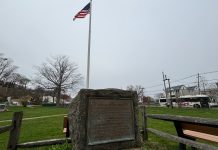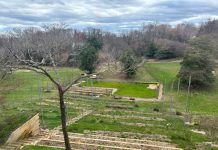By Eileen Moon
ATLANTIC HIGHLANDS – The weather outside was frightful, but inside the Atlantic Highlands Arts Council gallery at 54 First Ave. things were as sweet as – well, gingerbread – as the council hosted its semi-annual Gingerbread House workshop.
Sitting amidst an array of candy canes, gumdrops, nonpareils, Tootsie Rolls, marshmallows, sprinkles and cookies, about 15 aspiring gingerbread house makers glued their walls and raised high the roof beams under the expert tutelage of arts council board member Stephanie Ladiana and her husband Ulf Hjelm.
Swedish by birth, Hjelm came to the United States at 13 when his mother Barbro Linnea (Samuelsson) Hjelm married an American, and the family settled in Southern California.
It was some time after that when he began helping his mother make a gingerbread house each Christmas. For many Swedish families, making gingerbread houses during the holidays is a beloved tradition.
Although Germany lays claim to originating the gingerbread house tradition, according to the Swedish Tourism Board, by the 19th century it had become a popular holiday pastime in Sweden, inspired, somewhat creepily, by the Brothers Grimm and the legend of Hansel and Gretel.
In that ancient tale, a brother and sister have been led deep into the woods and abandoned by their family. Lost in the forest, the two starving children come upon a house made of bread and cakes and sugar and begin to feast on it. Soon they are imprisoned in the candy house, in the clutches of a wicked witch who plans to fatten them up and stuff them in the oven: A warning, if ever there was one, not to nibble on your neighbor’s candy house no matter how hungry you might be.
Fortunately for the sake of their story and ours, Hansel and Gretel escape unharmed.
In Sweden, gingerbread houses are called Pepparkakshus and are generally made with sugar, not corn syrup. “Corn syrup is an American thing,” Hjelm said.
Because Swedish bakers use metric measurements, Hjelm’s mother located an American cookbook called “Swedish Baking at Its Best” by Marianne Grönwall van der Tuuk that incorporated American measurements in its Pepparkakshus recipe.
Hjelm’s mother passed away many years ago, but the tradition she began continues. Hjelm uses the same recipe today, although it’s had some tweaking. “I make twice the batch because with four kids, you need twice as much,” Ulf said.
He and Ladiana are the parents of two sets of twins, Rita and Linnea, and Maggie and Peter, all of whom are now in their 20s.
The kids have been helping with the holiday gingerbread house project since they were old enough to wield a frosting tube.
The family long ago advanced from a simple four-walled house to elaborate constructions that include weeks of family discussions, architectural plans, patterns and cardboard models.
“My kids decided that a house was not enough, so we’ve built all kinds of strange things,” he said.
Among the gingerbread creations from years past are the Eiffel Tower, Twin Lights, and the Cathedral of Notre Dame. The cathedral construction took some precise planning. “My son sat down and figured out how to do the flying buttresses,” Ladiana said.
They also made a football stadium to celebrate their older kids’ graduation from Colorado State and the University of South Carolina a couple of years ago. This year, they’re making plans to construct Australia’s Sydney Opera House.
So what are the secrets to making a great gingerbread house? It starts with the dough, Ulf told the class of aspiring gingerbread makers. While they used pre-made houses for the workshop, each of them went home with a recipe for the real thing.
Initially, the Pepperkakshus batter will be soupy, Hjelm said. It’s necessary to keep adding flour until it takes on the consistency of Play-Doh. Then it’s time to employ your architectural skills. He uses a pattern to cut out the pieces of dough. After baking in a buttered pan, the pieces of dough are unlikely to come out perfectly plum. They will need to be cut carefully while they’re still warm. To achieve a smooth edge, he uses a hand-grater to plane the sides of the house down to an even thickness.
Then comes the magic part. After melting granulated sugar in a cast iron pan, Hjelm dips the edges of the gingerbread pieces into the hot liquid and glues the corners together at right angles as the pattern dictates. Within a few seconds, the walls are firmly connected. The larger pieces are more delicate to handle than accessory pieces like chimneys, and things do break occasionally. But there’s no crying in gingerbread house construction.
“There are people who go completely crazy with this stuff. I’m not one of them,” Hjelm says.
With the intricacies out of the way, workshop attendees moved on to making their gingerbread houses homey. Working individually or in family and friend groups, attendees applied royal icing with pastry bags, sketched in windows and doors and made their design choices until, in the end, no two houses were alike.
Atlantic Highlands residents Emily Hackett and her husband Cory Herrala came to the workshop with their son Leo, and Emily’s mother Barbara Berardo of Manchester, collaborating on a candy house that any gingerbread family would be proud to live in.“It was wonderful,” Hackett said. “It was really fun.”














